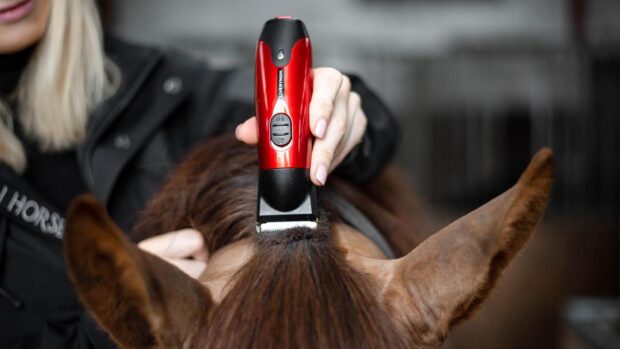The summer show season will be here before you know it, so now is the perfect time to brush up on your plaiting and Alan Davies is here to help. We hear from the top groom, who kept Carl Hester and Charlotte Dujardin’s horses in pristine condition for much of the past decade, to learn his top tips when it comes to perfect plaits.
From prepping the mane to why he prefers bands to stitching, discover Alan Davies’ plaiting secrets…
1. Don’t be afraid of using scissors
Alan explains that how you look after the mane will depend on the individual horse and their type of hair.
“For horses with thick, wiry manes, like Uthopia, I have to occasionally pull the mane,” he says. “But horses like Valegro or En Vogue, for example, have quite fine manes, so I tend to trim those with scissors.
“I let them grow as long as possible, then backcomb them a little and trim with scissors. I use the scissors on an angle so the cut doesn’t come out too straight, and it means you can slightly feather the end of the mane.
2. Keep your neck covers clean
“If your horse has neck covers on their rugs at night or during the day, make sure you keep the covers really clean so they don’t rub out too much hair, especially at the base of the neck,” says Alan, on episode 42 of The Horse & Hound Podcast.
“Manes often get thin there and then the plaits just fade out which doesn’t look so good.”
3. Look after the mane on a daily basis – and decide which side you want it to lie on
“Try to keep it clean, but without brushing it out too much,” advises Alan. “I use a comb on the manes day-to-day, just to get any shavings out in the mornings.
“Carl and Charlotte like horses’ manes to lie on the off side, so if we have horses arriving with manes on the other side, I’ll do half plaits to train it over onto that side.”
4. Don’t trim the mane too close to plaiting
“Let the hair grow for as long as possible to help it thicken, but don’t trim too close to a show otherwise the hair will be too thick at the end,” says Alan. “For plaiting, I want the mane to be nice and even, but slightly thinner at the ends.”
5. Don’t turn your nose up at elastic bands
It may surprise you that Alan’s perfect plaits, that have graced the cover of H&H on many occasions, are achieved using elastic plaiting bands, not through stitching.
“I find that it’s nicer for the mane and you don’t risk snipping hair with scissors when taking the thread out,” he explains.
“I use a plaiting spray to make the mane really sleek then plait down, making the plait looser at the top and tighter at the bottom. I turn over the end of the plait and put a band around it. Then I put another band round the end, keeping it looser, then roll the plait up through the band, turning the band round it as I roll the plait. Then I twist the band at the top of the plait and put it underneath so you can’t see it.”
6. If your plaits stick up, you might be plaiting from too much height
“I have adjustable steps I use; whatever you choose, make sure it’s safe so you’re not going to fall off and the horse won’t get its legs tangled,” says Alan.
“I like to be about eye level with the top of the neck. If I stand too high then plaits tend to come out sticking up a little, and if I’m too low they can be a bit droopy. I like nice perky plaits right at eye level.”
You may also be interested in…

6 plaiting products to help you create the perfect look

‘I taught Kate Middleton to ride’: 9 things you may not know about supergroom Alan Davies
How well do you know the dressage supergroom? Here are nine things about Alan that you might not have known….

Alan Davies stepping back from role as ‘super-groom’ to Carl Hester and Charlotte Dujardin

‘I sobbed all the way up the centre line’: Alan Davies’ highlights from his time as Valegro’s super-groom

Subscribe to Horse & Hound magazine today – and enjoy unlimited website access all year round
Horse & Hound magazine, out every Thursday, is packed with all the latest news and reports, as well as interviews, specials, nostalgia, vet and training advice. Find how you can enjoy the magazine delivered to your door every week, plus options to upgrade your subscription to access our online service that brings you breaking news and reports as well as other benefits.




